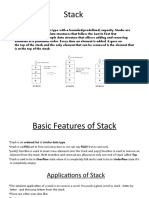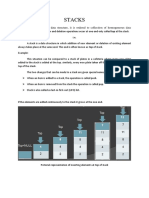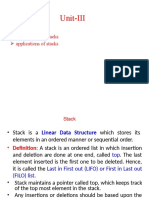0% found this document useful (0 votes)
17 views30 pagesData Structure
The document provides an overview of the stack data structure, detailing its LIFO nature, basic operations (PUSH and POP), and applications such as expression conversion and undo features. It also describes the implementation of stacks using arrays and linked lists, along with algorithms for enqueue and dequeue operations in queues, which follow a FIFO structure. Additionally, it covers notations for arithmetic expressions and the rules for converting infix expressions to postfix form.
Uploaded by
joelCopyright
© © All Rights Reserved
We take content rights seriously. If you suspect this is your content, claim it here.
Available Formats
Download as PDF, TXT or read online on Scribd
0% found this document useful (0 votes)
17 views30 pagesData Structure
The document provides an overview of the stack data structure, detailing its LIFO nature, basic operations (PUSH and POP), and applications such as expression conversion and undo features. It also describes the implementation of stacks using arrays and linked lists, along with algorithms for enqueue and dequeue operations in queues, which follow a FIFO structure. Additionally, it covers notations for arithmetic expressions and the rules for converting infix expressions to postfix form.
Uploaded by
joelCopyright
© © All Rights Reserved
We take content rights seriously. If you suspect this is your content, claim it here.
Available Formats
Download as PDF, TXT or read online on Scribd
/ 30
























































































